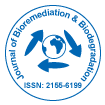Bioremediation by Natural carriers
Received Date: Jun 01, 2022 / Accepted Date: Jun 29, 2022 / Published Date: Jun 29, 2022
Abstract
Currently, the least expensive and damaging way to remove xenobiotics from the environment is by bioremediation of contaminated soil or groundwater. Microorganisms that can degrade particular toxins can be immobilised, which promotes bioremediation procedures, lowers their costs, and enables the use of biocatalysts many times. Due to its ease of use and lack of toxicity, adsorption on surfaces is the most popular way of immobilisation among developed methods used in bioremediation. A successful bioremediation depends on the carrier of choice. The type of procedure, the type of pollutants, and the characteristics of immobilised microorganisms must all be taken into account. Due to these factors, the article provides a summary of recent scientific studies on the effectiveness, the carrier's effect on microbes and pollution, as well as the type of research being done The twentieth century is remembered as a time of extraordinarily rapid technological and civilisational growth.
Keywords: toxicity, Adsorption, contaminated soil, Aerobic microbial
Citation: Guzik U (2022) Bioremediation by Natural carriers. J Bioremediat Biodegrad, 13: 514. Doi: 10.4172/2155-6199.1000514
Copyright: © 2022 Guzik U. This is an open-access article distributed under the terms of the Creative Commons Attribution License, which permits unrestricted use, distribution, and reproduction in any medium, provided the original author and source are credited.
Share This Article
Recommended Journals
Open Access Journals
Article Tools
Article Usage
- Total views: 978
- [From(publication date): 0-2022 - Apr 02, 2025]
- Breakdown by view type
- HTML page views: 662
- PDF downloads: 316
